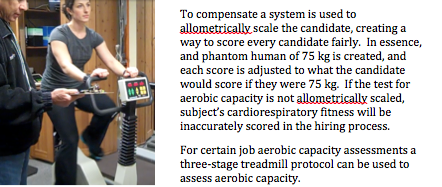AEROBIC CAPACITY TESTING
Purpose is to measure the candidate’s cardiorespiratory fitness. The candidate is asked to pedal a bicycle ergometer at 50 revolutions per minutes for three continuous, progressively more difficult, stages of two minutes each. At the conclusion of the exercise the heart rate and the workload will be recorded and used to score the candidates fitness. In general, if it requires more work to get the candidates heart rate up, they are in better shape. Some advantages of using a bicycle ergometer is 1) The simplicity of the skill of pedaling a bike, 2) the safety and reduced risk of injury, 3) the workloads can be standardized and the subjects body weight will not effect serial testing.
Compensation must be made for the candidate’s weight. Larger subjects must be able to perform more work than smaller subjects, but the relationship of workload to weight is not directly proportional. A subject twice the weight of a smaller subject is not required to do twice the work. Absolute scoring, (candidates pedaling with the most resistance) favors the larger candidates, and relative scoring (work performed per pound favors the smaller candidates.

COMMON STRENGTH ASSESSMENTS
Grip Strength
For many physical assessments grip strength is assessed in the right and left hand. Assessing grip strength in occupations that require handling of heavy equipment and hand tools would prove valid when assessing a candidate’s minimization of risk to injury on the job.
Ground to Waist
Many job physical requirements involve lifting a piece of equipment or tool or person from the ground to the level of the waist. Examples may include lifting a stretcher to an ambulance, a jackhammer to the bed of a pickup truck, or a lifting a manhole cover. For assessing the strength needed for these job skills we have a computerized strength assessment machine and software to simulate dozens of job specific tasks with greater accuracy. Typically the squat and bent over row exercises are the lifts of choice when assessing ground to waist strength.
Waist to Shoulder
Another strength component is the ability to lift a weight from the waist to the shoulders. Examples could include lifting the ladder on to a Ladder truck, lifting a cross arm to a utility pole, or lifting a coil of wire. . Typically the arm curl and upright row exercises are the lifts of choice when assessing waist to shoulder strength.
Shoulder to Overhead
Lifting and working with a weight overhead could include placing a smoke ejector fan on a doorway, changing a ballast on a light fixture, or placing a length of pipe on a truck. Typically the shoulder press exercise is a controlled lift that can easily simulate the strength needed to perform the task identified. A submaximal weight is often used and an increased number of repetitions can ensure maximal strength estimates can be done safely.

MUSCULAR ENDURANCE ASSESSMENTS
Muscular endurance assessments are performed with a Baltimore Therapeutic Equipment (BTE) Work Simulator II. Every effort is made to make the assessed physical requirements match the specificity of the job. Tasks may involve a specific number of repetitions or a certain amount of time performing the task in question.

FLEXIBILITY ASSESSMENTS

